As you know one of the main components of any home is the roof. But before it is necessary to select the material to equip, from which it will be formed. And to solve this problem, you need to know what types of roofing materials are, as well as their characteristics and scope of use and that of the proposed best to choose for the house.
types of roof
First and foremost it is worth noting the main varieties of roofing materials. In particular two types of notes:
- sheets
- soft materials
For better understanding it is worth considering each of the groups and the main varieties.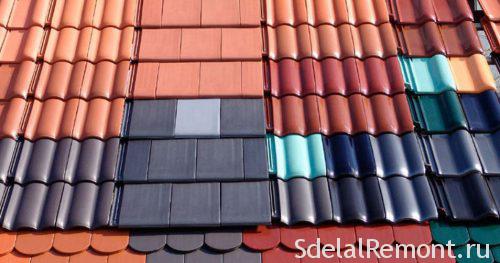
Sheet metal roofing materials
This kind of, as the name presented in the form of sheets of different shapes and made of various kinds of materials. Let's consider in more detail the variety of this type of roof and the main features of each of them.
metal
This corrugated steel sheet,, having a size of 1 m × 0,5. Its surface is covered with mineral granules in an acrylic binder. Externally very similar to ceramic metal.
In our country it is available in the form of sheets of galvanized steel, slightly profiled, without exterior finish.
These types of roofing are very common in the individual building and successfully replaces galvanized steel sheets.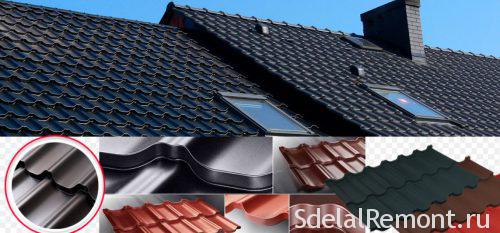
Roof with such a coating is at least 50 years old. The height and size of the sheets are extremely diverse.
The disadvantage of this material is a considerable susceptibility to corrosion due to the specific properties of aluminum.
With this material can be made home repair roof roof with his hands, having an indefinite useful life. Its thickness reaches 0,6 or 0,8 mm, width - 670 mm. Installation of this type of roof is very time-consuming and impossible without the presence of special skills. First finished roof has a shiny surface, which subsequently darkens.
dignity:
- Easily and quickly mounted.
- The high level of strength, thus withstand the load and shock.
- Relatively low cost
- low weight (to 5 kilograms per square meter)
- Transportation of the material does not require special conditions and respect.
Among the disadvantages of material:
- A large percentage of waste after work
- Strongly conveys noise, that appears when striking the roof, for example during rain or falling branches.
Proflist
The next type of roofing is becoming profiled decking. It is made from the same metal as the tile, the only difference is becoming smaller number of layers. In particular the steel sheet treated with zinc layer and the aluminum.
Among the species you can see different variations of the profile, namely wavy, triangular, rectangular, etc..
More often all use a coating for industrial and commercial buildings. Also covered shops, refueling and car wash.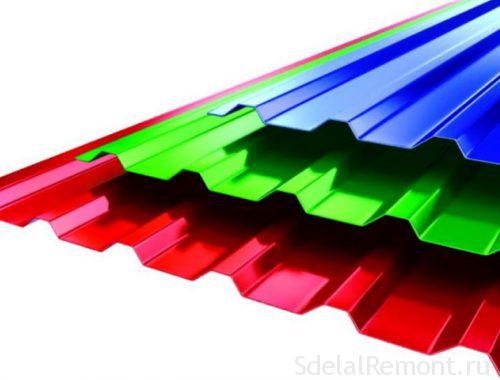
Product Benefits:
- The service life of up to 50 years old.
- Relatively low cost (about 600 rubles per square)
- Is light to install
- The high level of flexural strength.
Among the shortcomings can be noted a need for additional sound insulation, because it is a bustling material.
onduline
Coating of natural materials. The composition can be detected cellulose fibers, impregnated with bitumen. The surface of the polymeric paint is further painted, which gives the material a more elegant look.
In another of these lists are called evroshifer.
Quite often, the material used for the coating sheds, gazebos and garages. It is also used to shut off the old slate, giving it a new life.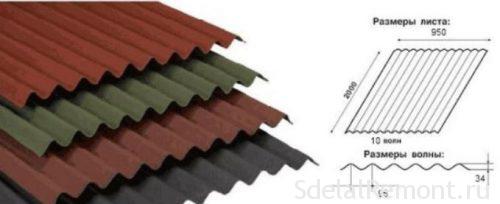
A good advantage of the material becomes flexible, it can be used even with non-standard finishing of complex shape of the roof.
Benefits:
- Operational period up to 40 years old.
- High level of water resistance, along with hygienic and environmentally friendly.
- The material is impervious to chemical attack.
- Can withstand loads up to one ton per square meter.
- Is light in handling and installation.
- silent
- The cost of material about 300 rubles per square meter.
disadvantages:
- The limit of the allowable temperature for the material 110 degrees, at higher rates, he begins to break down.
- Over time, the paint fades.
- In dimly lit locations grows fairly quickly moss (for several years).
- The heat softens the roof and begins to smell bitumen, because you can not climb on it.
Metal roofing materials
Metal roofing is used in the construction of a number of reasons. First of all, it is different durability (her life - about 20 years old); Secondly, It does not require complex care (galvanized steel sheet care is absolutely not necessary); third, it is the easiest (with no more than a crate 15 kg 1 m2), resulting in possible savings of lumber, due to a decrease in the size of the wooden section roof framing members.
roofing iron (cold-rolled steel sheet) may have a thickness of 0,35-5 mm, width of 500-2300 mm, and in some cases allows the length of the material roll into rolls. In most cases, steel is used in roofing, having a thickness of 0,35-0,8 mm. The dimensions of the sheet may be 710 × 1,420 mm, 1000× 2 000 × 750 mm and 1500 mm.
In operation convenient and steel roll, as on the roof there is less water to leak allowing seams. However, in most cases, used sheets roofer, having dimensions of 710 × 1,420 mm. Material consumption is 5,1 kg on a roofing steel 1 m2 roof.
Together with the black and galvanized steel produced, on two sides covered with a layer of zinc, having a thickness 0,02 mm.
To prevent corrosion black steel to be coated with grease. Roofing iron must only be stored in a dry environment. When a rather prolonged storage the sheets should be cleaned from grease and proolifit on both sides. The most reliable protection material is a coating of oil paint drying oil.
These kinds of roof covering - is of aluminum or galvanized steel sheets, stamped in a tile coating.
Sheet sizes vary among different manufacturers. Exterior coating metal may be made of dyed polyester, polyvinylchloride, plastisol and several other polymeric materials, whose thickness is 20-70 microns. With increasing thickness of the polymer layer material strength increases and therefore its service life is prolonged.
Slate
Among all types of roofing slate is considered to be the most affordable. In addition since the Soviet times most popular. The composition of the material 85% cement, rest 15 asbestos. Standard sheets of such material from weigh 10 to 15 kilogram. All sheets of the same length, 1750 millimeters, while the width can vary between 980 to 1130 millimeters. In turn, the width of the indicators determines the number of waves, and they can be from 6 to 8.
If before the slate in the wings most of the buildings, from residential and industrial areas, today it finds its use mainly in the regeneration of roofs of sheds and outbuildings.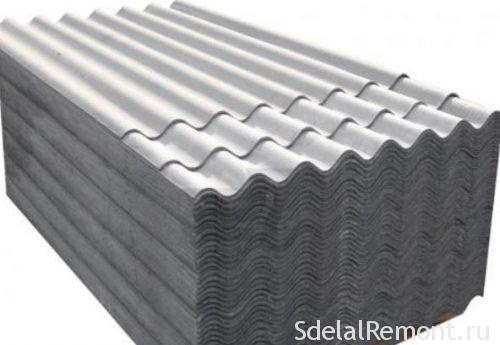
Benefits:
- Pretty big operation period - 30-40 years old.
- The high level of durability under shock loads and bending.
- Easy to process. Trimming sheets at the desired size by simple grinder.
- Material incombustible.
- It has a low cost, average 120-150 rubles per square meter.
among the shortcomings:
- Over time, there is an allocation of harmful substances (which leads to asbestos).
- The material is quite fragile.
- It has a high level of hygroscopicity, in consequence of that collects moisture, which causes the formation of moss.
Seam-ply roofing
It represents a straight steel sheets, that facilitate removal of moisture from the roof. Used material with zinc processing, or pure. It may further be processed plastic protection.
Title compound material due to the method of sheets, who called the rebate. Represented as a single or double, as well as vertical or horizontal. It caused this kind of attachment, the width or the length.
Use this type of material in the regeneration of roofs of cathedrals and homesteads. Also hiding industrial premises.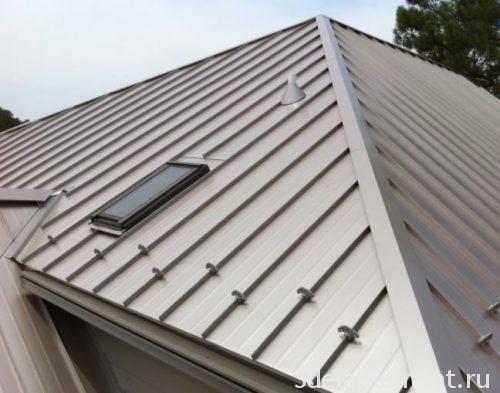
dignity:
- The service life of the 25 to 30 years old.
- Low cost - 300-400 rubles per square.
- Ogneupornosty.
- Attractive appearance.
- High level of flexibility, that allows you to equip the roofs of complex shape.
- Resistant to temperature extremes.
- Sheets fairly easy (4-5kg).
disadvantages:
- Shock loads can damage the coating.
- Use a material with the necessary additional thermal insulation.
- A small number of specialists, which is capable of qualitatively fulfill the roof of a material.
- Often accumulate static elekrichestvo roof.
- Big noise level, that requires additional insulation.
Seam roof of aluminum and copper
According to its principles and mean virtually identical version of the past. The only difference then becomes, that the roof does not corrode. It is also noted higher weight, in particular, copper roof weighs up 10 kilogram.
pros:
- The service life of up to 80 years old.
- Virtually maintenance free, sufficient rare flushing roof.
- Material incombustible.
- Completely eco-friendly and safe.
- Impervious to corrosion and chemical attack.
- It has excellent decorative features.
Among the shortcomings noted a high cost, in particular about 2000 rubles per square meter.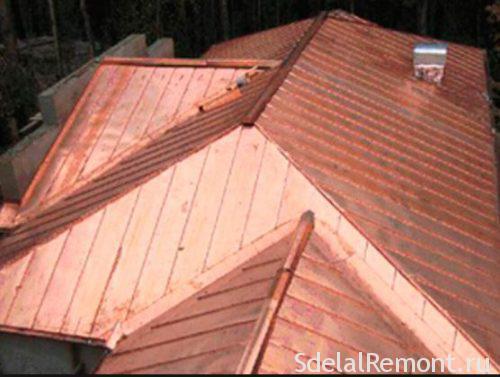
Soft roof and its species
With sheeting figured, Now pay attention to the following form, namely soft roof.
shingles
This is the first kind of soft materials. Another name for such a shingle or shiglas. At the core of fiberglass composition, which is impregnated by a special technology with additional bitumen modifiers, is applied from above the basalt or slate chippings for decorative effect. Besides, the last layer performs not only a decorative function, and also plays the role of protection from ultraviolet radiation. On the reverse side of a bituminous self-adhesive layer applied. For laying enough to warm it up and stick to the base.
This form is used in the regeneration of all types of roofs, even the most complex shapes. It is also common in the decoration of the attic.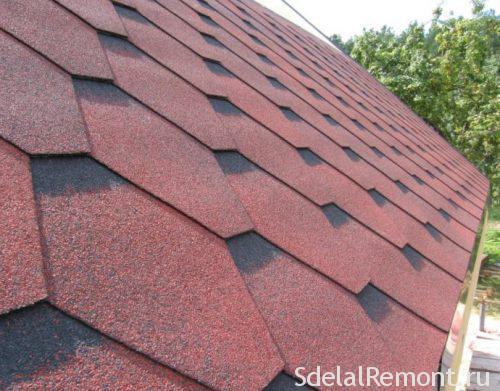
Benefits:
- The service life of up to 70 years old.
- cost of 400-500 rubles per square.
- Delays snow on the rough surface.
- It has good decorative qualities.
- Incorrosible, also condensation.
- The material is quite flexible, which allows the operation of any complexity.
disadvantages:
- When the frost becomes hard and brittle.
- At high temperatures, melts and releases an unpleasant odor.
- combustible.
roll roofing
Another embodiment becomes flashing. Such a coating is also made on the basis of glass fiber, moreover presents the variation of polyester and fiberglass.
Each has a particular VOI:
- Polyester is strong enough, but expensive.
- Fiberglass is a certain balance between quality and price.
- In turn, fiberglass pretty cheap, but classy.
The very foundation of poured asphalt with modifiers. After which the top is held sprinkling sand, mica or slate.
It used a covering mainly in buildings with flat roofs, or used as a waterproofing.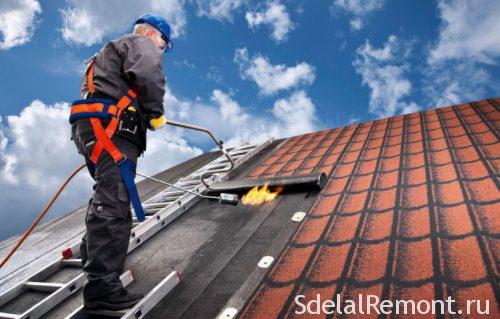
dignity:
- Life time 50 years old.
- Requires no maintenance.
- is not dangerous, as well as completely harmless.
- It has a low cost, average 100 rubles.
- Low weight.
Minuses:
- Storage shall be only in an upright position, no additional heating, and away from heating appliances.
membrane roofing
Sldeuyuschim view becomes thick membrane coating to 2 millimeters. Distinguish these three types, depending on substrate:
- PVC coating.
- EPDM
- STRAYK
The first kind is not eco-friendly, but at the same time provides protection from ultraviolet radiation and fire.
EDPM are made from synthetic rubber, which is further reinforced polyester. Such coatings are quite durable, and at the same time completely safe for human health.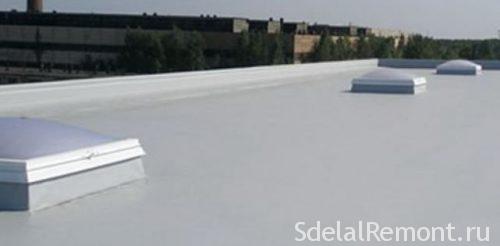
TPO manufactured from olefins having additional reinforcement, also durable and environmentally friendly.
Its application of such coatings on flat roofs finding, mainly public and residential high-rise buildings.
pros:
- low price (300-400p).
- Durability (life to 50 years old).
- Have a greater width, allowing any size roof cover.
- Installation work can be carried out at any time of the year.
- Not in need of repair, and besides fit as quickly as possible.
- A high puncture resistance.
among the disadvantages:
- Required most thorough preparation of the base and its alignment.
- Not resistant to chemical attack.
piece materials
And the last category are marked piece materials, which are also shared by some types of.
ceramic tile
One of the oldest roofing, appeared on the series with a slate roof and wooden shingles. Manufacture is carried out by calcining clay at a temperature of more 1000 degrees. Through such processing, the coating becomes very hard and durable. Color mostly standard, brown with reddish. But also allowed and painting surfaces.
Some of the more expensive types of optional glazed, which increases water repellency properties. Tiles are presented as squares and have a width 30 centimeters. Weight of one unit of 2 kg.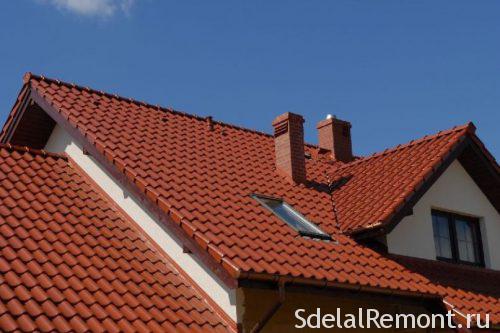
Shared by several types of tiles, in particular:
- tape flat.
- Pressed grooving.
- band grooving.
- One and two-wave.
- Drilling and grooved.
It is used mostly in private homes of wood, brick or stone of any number of storeys.
dignity:
- Can serve a neighborhood 150 years without repair.
- It does not require special care (Cleaning requires no more 1 once a year).
- It provides good sound insulation.
- incombustible.
- Insusceptible to temperature, stand up 1000 cycles of freezing and thawing.
- A large range of profiles and colors.
- Can absorb and evaporate moisture.
- Incorrosible.
Minuses:
- Great weight material, which requires the strengthening of the roof.
- quite fragile.
- The complexity of installation, requiring additional insulation and construction of fixtures.
- The high cost of the material 1000 to 3000 rubles per square, depending on the type of.
cement tiles
This coating creates a sand and cement without additional roasting. Through the use of dyes has a large range of shades. Top additionally applied glaze, which provides good aesthetic quality. roof weight to 40 kilograms per square meter.
It can also be used as the ceramic in all homes.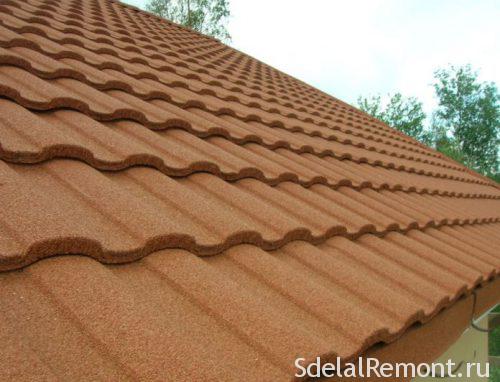
dignity:
- Guarantee from the service by the manufacturer 30 years old (in most of its operational period 50-70 years old).
- Relatively low cost of ceramic (to 1000 rubles per square).
- Nevospreimchiva UV.
- It carries up 1000 freezing cycles.
- Not destroyed by chemical action.
Minuses:
- Compared with the ceramic - a large thickness.
- Quite a lot of weight.
- during transport, about 10% the average breaks because of the fragility of the material.
Slate roofing
Coverage of natural slate, which is treated to impart a desired shape. The material is considered to be elite, and it can be seen in ancient castles, and more rarely in private homes.
dignity:
- Operational period up to 200 years old.
- Remarkable appearance is unparalleled.
- Protection from exposure to sunlight.
- Pozharobeszopasnost, environmental friendliness, water and frost.
Among the shortcomings can be noted too high cost, which ranges from 3500 to 7000 rubles per square meter.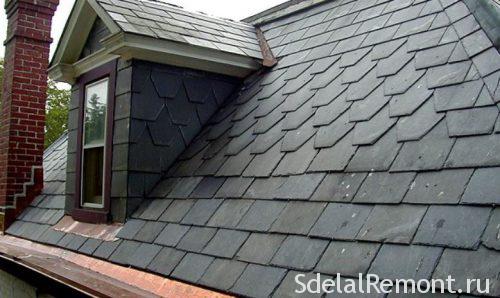
tanker roof
And the last view becomes mastic roofing, which is a special membrane. It is a liquid, sozdannnuyu based oligomers. After applying the coating by oxygen stiffens, forming a kind of film.
The high level of adhesion to metal surfaces, concrete and asphalt. By themselves, such coatings may be represented as:
- unreinforced.
- reinforced.
- combined.
Often used in the regions, where there is a severe winter, along with very hot summers.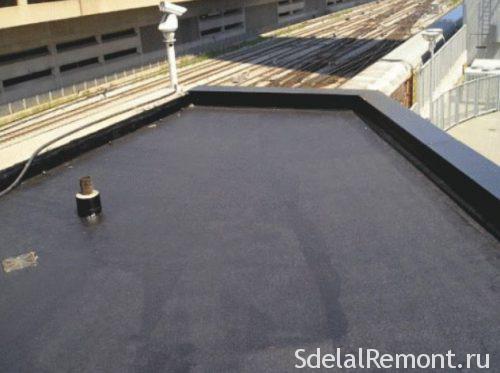
dignity:
- Provides high level of moisture protection.
- quickly mounted.
- It has no seams.
- The full composition of solvents and no harmful substances.
- The coating is resistant to fire and to low temperatures.
- Relatively low cost of 300 rubles.
disadvantages:
- It is difficult to achieve a uniform distribution of matter and do all the same layer.
- High-quality formulations to achieve cost 2000 rubles per square.
conclusion
Now, Having considered all types of roofing, you can choose the, that have more than you like. The main thing to consider not only the appearance, but performance materials. And finally, we offer you a look at a few videos on the topic:












